The lawns in the neighborhood are reappearing, though my shady garden remains snow covered but for small areas exposed to the winter sun and beneath a few evergreens. On this sunny, nearly warm afternoon I toured the garden to take a closer look at the damage from the early February storm, the first I have been out since my struggles in the knee deep snow more than a week ago.
Over the past weeks I have witnessed extensive damage to large evergreens, notably Leyland cypress, the native eastern red cedar (actually a juniper, Juniperus virginiana), scrub pine (Pinus virginiana), and southern magnolia. Of deciduous trees, Japanese maples have been damaged most commonly and to the greater degree, a consequence of their dense and wide spreading branching. There are assorted shrubs and smaller evergreens that remain partially buried, but I have seen enough to expect that injury to most will not be substantial.
From my garden I have taken several photographs of damage and pruning that might be helpful in repairing some of the damage you’ll find in your garden. I have addressed only a few branches on a handful of plants, and will wait for the snow to melt further before undertaking the larger project. I expect that you should do the same, since there is no immediate danger in leaving this task for a warmer day.
If you are to consider taking on the project of pruning and cleaning up, you must first be armed with the proper tools. Most important is the hand pruner, the tool I have used in demonstrating the pruning cuts in the following photos. For making a clean cut bypass pruners (the blades overlap like scissors) are best. Bypass pruners are offered with an assortment of ergonomic handles, and some are gear driven to give a mechanical advantage to hands with less strength. For this task we require only a sharp, sturdy tool, since many cuts will be made and we want a crisp, clean cut. 
Other tools that might be necessary are loppers (long handled pruners for cutting larger branches), a pruning saw (such as the folding saw in the picture), and a chainsaw (for major branches or for removing a tree at its base). In circumstances requiring a chainsaw please use caution, and if a branch is not within easy reach I would recommend a professional do the work. All cuts should be left untreated by pruning paints or sprays, and cavities left when a branch tears should not be filled. These treatments have been proven ineffective, and might cause damage. 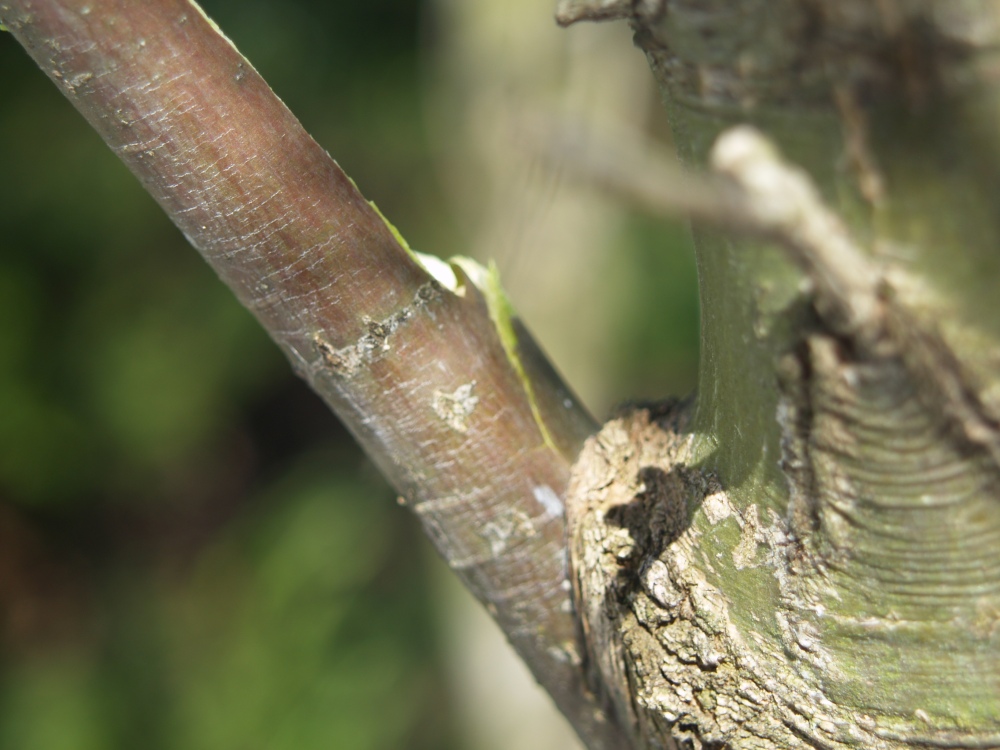
In the photograph above a branch of this upright growing Japanese maple has split, and the branch has broken off. The pruning cuts shown here should be duplicated as closely as possible on branches of deciduous or evergreen trees and shrubs.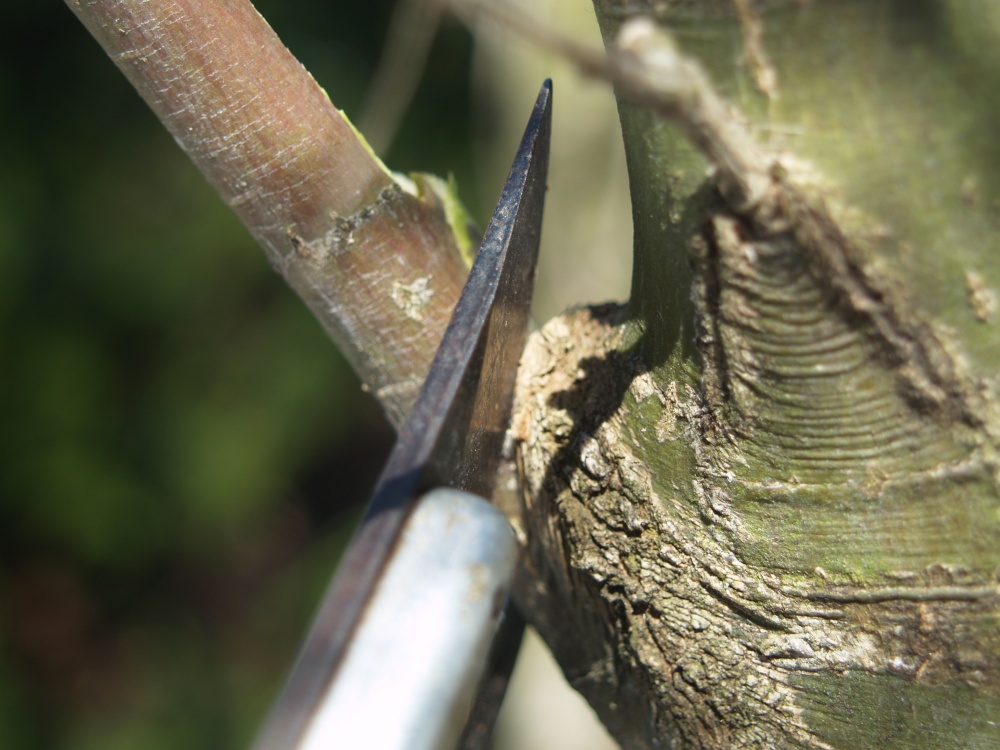
In the picture above, I have placed the blade of the pruner near the base of the larger branch, but not flush with the branch. The cut is made just outside the branch collar, the area that flares out from the larger branch. Leaving this allows the tree or shrub to repair itself to cover the wound.
Above, the cut has been made, leaving the branch collar, and onto the next. Not every branch will be pruned so cleanly, as we’ll soon see.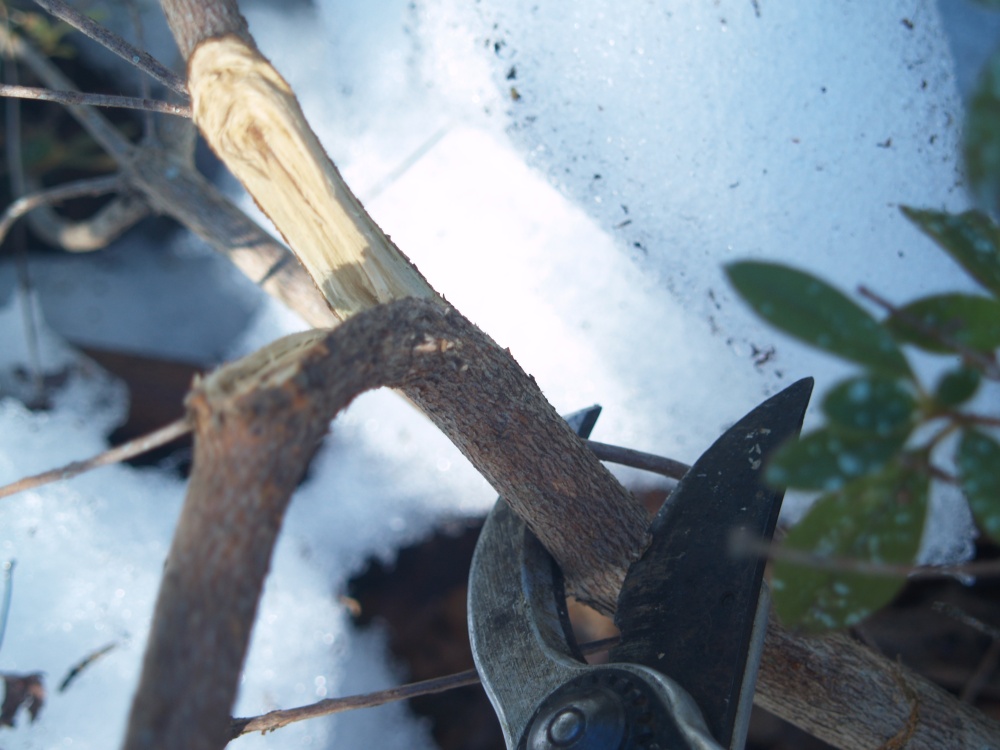
In the example above a branch of a large azalea has split. Fortunately, in my tour around the garden I saw much less damage to azaleas, rhododendron, and andromeda (Pieris) than I expected, since their branches are somewhat brittle and often broken in handling.
The pruning cut should be made just above the next branch down from the break. In this case that is a very small branch, but the azalea will grow from the point of this cut. If I had made the cut nearer the split the branch would probably die back to the lower branch.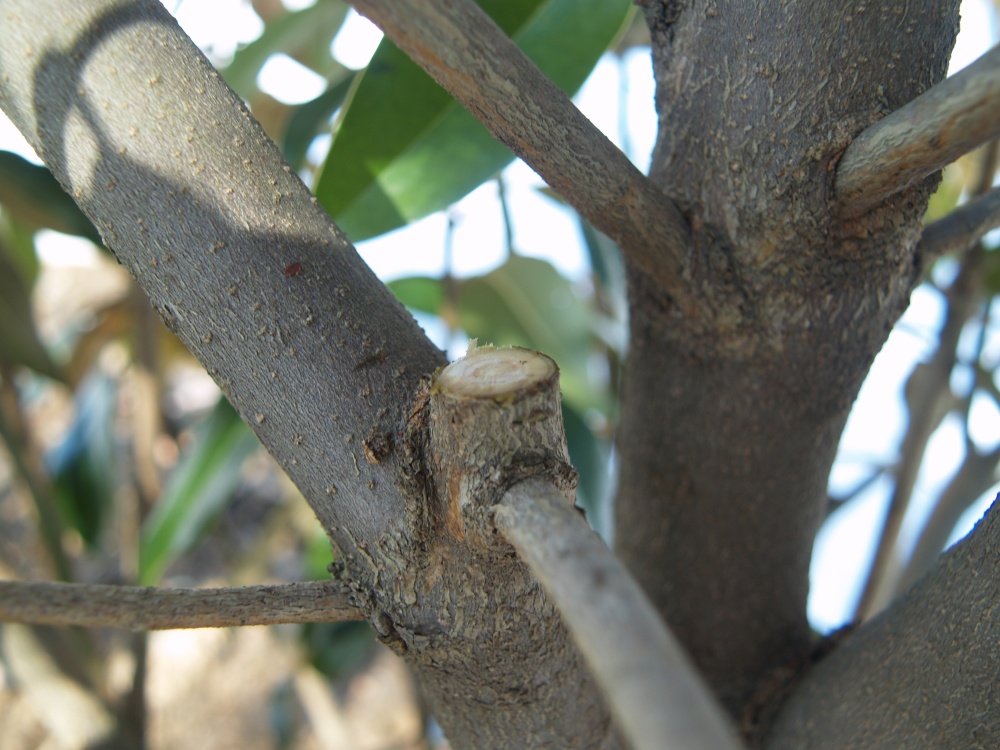
In some cases a flush cut with the branch collar is difficult or impossible, as seen above on a smaller broken branch of a southern magnolia. Here, a smaller branch made the correct angle cut impossible, so a little extra bit of the branch was left. It is better to err by leaving too much rather than cutting too close.
In the photos above and below branches have broken leaving a cavity into the larger branch. I will remove as much of the branch, and leave as much of the branch collar as possible, but the break tore the collar and the wound will not heal cleanly. I don’t think that the damage is so severe to warrant pruning down to the next branch, so I’ll take the chance that this will suffice.
Thus far we have addressed only pruning cuts made with hand pruners. The process when using loppers on larger branches is similar, though it can be more difficult to prune as closely to the branch collar. On branches requiring the pruning saw, or chainsaw, it is best to make a partial cut from the underside of the branch, but not enough so that the branch pinches the saw blade.
If the shallow cut at the branch’s bottom is not made, and the saw cut is made from the top only, there is a danger that the bark will tear or that the branch will break when the cut is partially made, further injuring the tree.
If pruned properly, trees and shrubs will react to the pruning cut by sending growth from that point. With the root system of a plant several years old growth will be rapid, and in many cases the gap created by the broken branch will be filled in a few short years. Japanese maples and many shrubs will grow multiple branches from the growth buds below the cut, and could fill in for the missing branch even sooner.
In the coming weeks we’ll address other snow damage issues, in particular, branches that have been bent out of shape. Many will not immediately spring back into their original position, so we’ll work out remedies to persuade them.
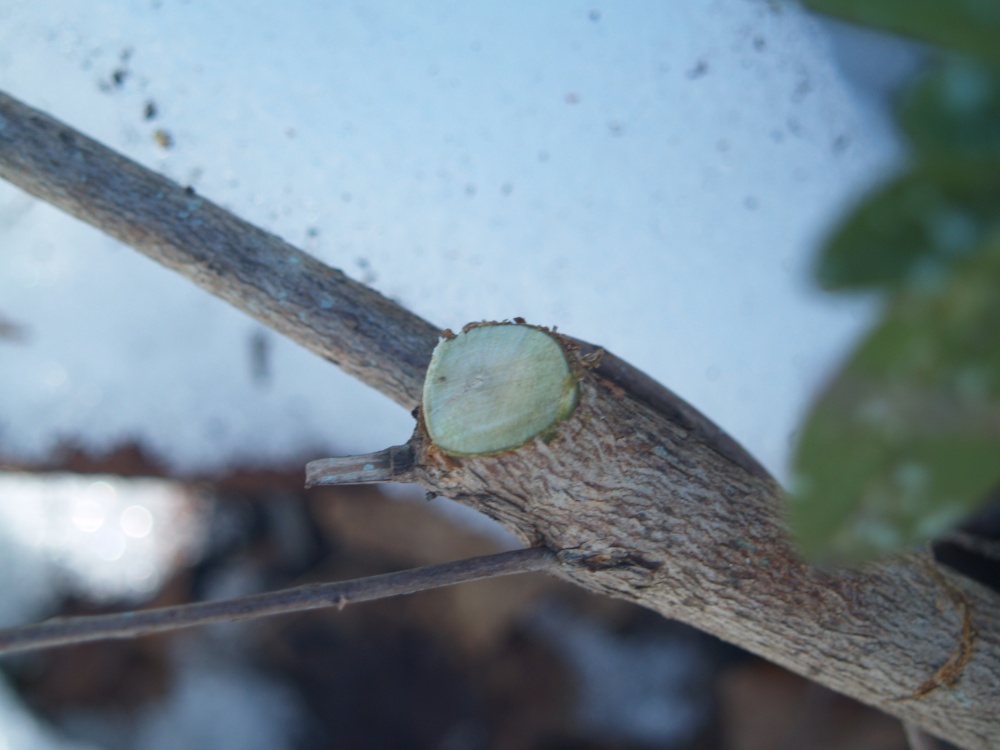
Do you have any suggestions to Leyland Cypress ‘s that have come uprooted? they are very tall; about 30 feet or so? And a couple of them have split?
Thnak you for showing the damage and suggesting solutions for the snow problems we experienced this winter. I was almost in tears when I saw how badly everything looked as the snow retreated.
Nature happens despite our protestations. I’m holding to my outlook that the damage is proving less than initially feared. I’ll be going out into the soggy garden, rain or shine, on Saturday to tie up some of the evergreens that have flopped about and to cut a few branches to see if I can restore some semblance of order. I’ll takes photos and report back before the start of the week.
We have about 8 fifteen feet tall Leyland Cypresses along our fence. The recent heavy snows we got this year has made them droop to the ground.
The roots appear fine and the first five feet of the trunk is straight. They have sprung back a little but are still bent quite a bit. Will they eventually spring back as the weather gets warmer? Or do I need to prune them? And if so, how much?We live in the DC area. Thanks.
As long as the roots and most of the trunk are straight then the Leylands should be okay. I would expect that the top should continue to straighten up as the growing season begins. However, since the branches are within reach, you can help by pruning the upper branches back by a quarter to a third. The lighter weight will help the top to straighten.
Thanks for the quick reply. By the upper branches, do you mean the sides or the very tops?
I am in need of some remedies for brances that have been bent out of shape on my shrub. When should I expect information onthat topic to post?
Thanks
Check back today. I posted on this topic Sunday evening.
Dave,
My leylands provide a beautiful and very effective barrier from my neighbors house, which is directly behind and above my house.
However, they sustained damage from the heavy snow, and I have questions about pruning the damaged limbs on my leylands trees.
I have created 4 pictures to show you the damage. These can be found on:
http://tinyurl.com/y9gwh5r
Pictures 1 and 3 show the damage, and pictures 2 and 4 show the red lines which are “guesstimates” on how much of the branches to cut off.
In a comment above on this page, you said to cut off about one quarter to one third of the branches. Is the goal to cut off as little as possible to lighten the branches enough to let them grow properly? Should you cut off more than one third if that’s what it takes to get the branch to resume its previous upright position?
Also, if I cut the branch back to where there are no smaller branches left, leaving only the main branch itself, is that too much to cut off? Will that branch begin new growth below the cut?
Actual green growth on many of the branches doesn’t start until the last half or the last third of the branch, due to the size of the trees and the length of the limbs.
Any tips you can provide would be helpful.
Thanks.
Jeb Ramsey
Sterling, VA
I think that the red marks that you’ve made on the photos are just about the right amount to cut. I would not prune the Leylands to the point where there is no foliage. Our goal is to lessen the weight of the branches so that they spring back closer to their original position while also maintaining the tree’s shape. Where branches are severely bent the best that we can hope for is to prune the bent branches so that they don’t detract from the conical form, and then new growth will fill any gaps left by our pruning. In the worst case I would prune all branches back to a narrow conical shape, and Leylands will grow quickly to fill in.
My grass looks smashed, trampled and the blades are white. What can I do to resurrect my yard?
My grass has snow damaged. It looks like it has been trampled or smashed down and the blades are flat and whitish looking. What can I do to resurrect my yard?
It’s not unusual for grass to look ragged and forlorn at this time of the year. With our recent warm temperatures grass will begin to grow rapidly.
If yours doesn’t recover in the next couple weeks then you will probably need to undertake some renovation, which could entail aeration to help relieve compacted clay soil and topdressing with compost, reseeding, and fertilizing. If you don’t see a turn for the better in the next two weeks I would advise calling to have a professional take a look to see what they recommend.
I have a very old azalea that the snow split down the middle of it’s main trunk. the bush was about 6 feet high, with essentially one main trunk giving off one large, branch that leafed out and bloomed.) The main branch, which is the part that split off, is still about 50% connected to the trunk and has healthy leaves and blossoms, but there are no budding points or branches below the split. I feat that if I prune it, that’s the end of the bush.
Help!
From your description I don’t think that there’s much of a chance that the branch that’s hanging on will survive. Although there are no branches or obvious buds below this point, with an azalea there’s a good chance that there are buds that will sprout new growth after it’s pruned.
need info on trimming bent over upright junipers that are not recovering by themselves from a heavy spring snow
I think that you might find the answer on this follow up article https://davermfarm.wordpress.com/2010/03/14/split-and-splayed/. If you have any follow up questions please let me know.
I’ve 16 beautiful leyland cypress shrubs. I’ve noticed this spring that
all of the shrubs have a noticeable amount of dead spots!!!!!!!!!!!!!
Very concerned about what this damage was caused buy. Should I
remove all the dead spots,or let them grow out; if possible?????
HELP
Leylands have suffered considerable damage from snow that past two winters. If you are able to reach the injured branches to prune them out then this is best, but if not, there is little risk in leaving the dead in place. I expect that the leylands should grow as normal, and any holes from the missing branches will be covered over quickly.
How to tie up a juniper that was bent apart from the snow. Someone mentioned typing round and round with light ripe. Do you know of this?
In some instances when a juniper is tied up the branches will gain rigidity and maintain their shape. However, many times I’ve seen the branches fall back out once the rope is removed. The best repair for upright growing junipers is to cut them back and let them regrow, but this often isn’t practical.
Will spider mites always come back even if you kill them the year before?
Spider mites will not always return, even if they are not killed. If spider mites are killed by an insecticide they might have laid eggs for a future generation. Also, susceptible plants are likely to attract spider mites as long as conditions are favorable. There are highly susceptible plants in my garden that have had spider mites a time or two in twenty five years, but I’ve never lost a plant or seen any more than minimal damage, without ever spraying to kill the mites.